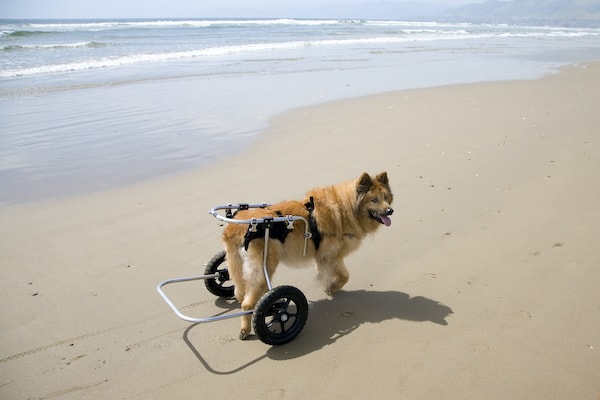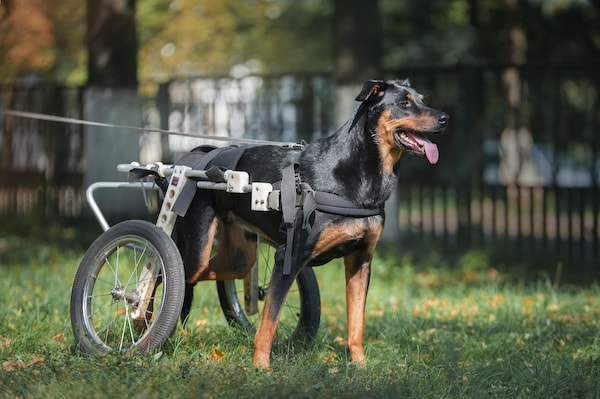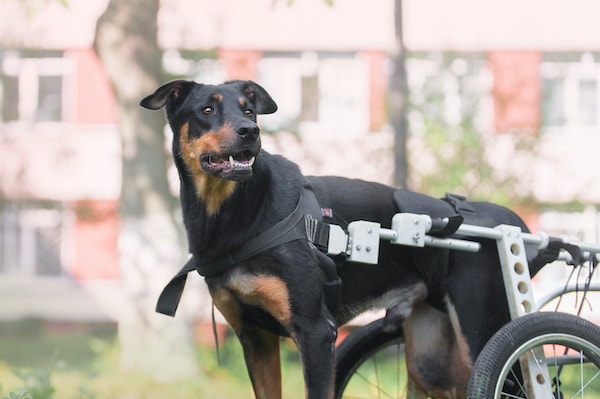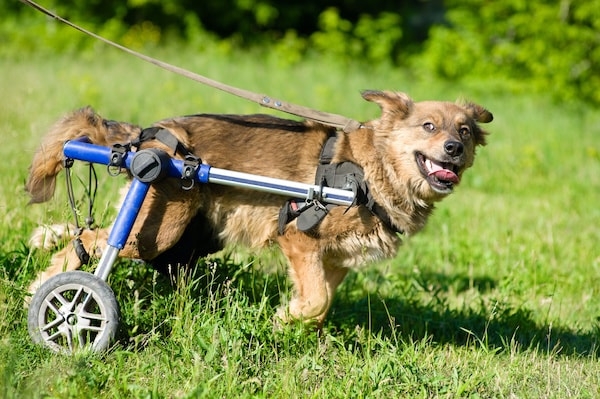Wheelchairs for large disabled dogs are often needed by owners to get their pets in and out of their house. Many dogs won’t be able to get into a car without their owner’s help, which can lead to frustration on both ends of the equation. This makes most owners simply decide not to take their dog out in public. Because of this, wheelchairs for large dogs were designed to allow the owner to get their dog moving in the world.

Do you have a disabled pet that you’d like to take out with you? This article may help provide some ideas to keep your disabled pet mobile and active!
Contents
Find The Most Suitable Option For Your Dog
When you own a pet that’s disabled, the first thing you need to do is to make sure you find something that’ll allow them to easily move. But, before buying anything, it’s important to consider the following:
- Your dog’s size
- The area that’s affected by the disability
- How you and your pet can adapt to the wheelchair around your home
Some wheelchairs may provide different strapping options, such as a dog wheelchair for back legs. Because of this, it’s important to find something that provides comfort, especially when it’s worn for a long time. These are very useful for getting your pets on their way and helping to keep them mobile.
If you don’t have a wheelchair or similar item, you may want to consider getting a special pet carrier for your disabled pet to use. With this, you can keep them in a portable position.
Ensure Your Dog Has Enough Space to Move Around
If you’re moving from one room to another, you need to make sure that your pet has enough room to get around and be able to run and play. A large piece of furniture or other items may cause problems with your pet as they may get caught or stuck with it. If you don’t have enough room, it may be a good option to rearrange your furniture to help create an ample amount of space.

If you have a dog that’s struggling with mobility, it’s crucial to make sure that they learn how to be mobile so they won’t get lost. This is important as it allows your dog to live a full life and live in the community. For example, if you live on a farm and have livestock, you need to make sure that your dog has access to your house, barn, fence, roads, and sidewalks.
If there are certain areas where your disabled dog is having difficulty to access, make sure to add a ramp or some other kind of handicap aid so they can go to the areas that you want them to go.
Make Sure to Give Your Dog Enough Drinking Water
Next, you need to m8ake sure you give your pet plenty of water to drink. Water is vital for all pets, especially disabled ones. Thus, you may want to bring with you a water bottle while on the move in case you’re going to be away for a while.
Consider Alternative Therapies
A holistic approach is also another possible way of helping your disabled dog regain their mobility. Some of the methods you need to consider include physical or massage therapy. However, to avoid causing your dog harm, you need to avoid any questionable therapy technique. As an alternative, you should focus on the physical therapies that target and restore the weakened muscles, which may improve your dog’s mobility over time.

Another treatment that may help your disabled dog regain their mobility is water weightlessness. One research showed that disabled dogs, especially those suffering from intervertebral disc disease, benefit a lot from acupuncture. It was also discovered that these dogs recovered faster when they received electro-acupuncture and Western treatments.
Incorporate Appropriate Training For Your Disabled Pet
It’s often said that disability isn’t an inability, which may also apply when it comes to your disabled dog. Therefore, you need to start teaching your dog new tricks that help them become more mobile. Also, you should opt for an exercise routine that your dog enjoys. This is crucial as it’ll keep your dog engaged and may help them regain their mobility.
The training you choose also needs to be suited to your disabled dog’s needs. For example, if your dog uses a wheelchair, specific commands such as ‘sit’ aren’t appropriate. Instead, you should opt for suitable commands such as telling your dog to roll back and stay.
With continued training, your disabled dog may be able to move independently from one point to another. If you’re a dog owner, this gives you peace of mind knowing your dog gets to live a normal life.
Check Up On Your Dog Each Day
To confirm that the paralyzed limbs don’t have any further injury, it’s vital to do a daily check on your disabled dog. This is because, unlike their healthy counterparts, it might be a lot more challenging to notice an injury with your disabled dog since they most likely won’t be showing any signs.

With these daily checks, on the other hand, it’ll be a lot easier to know if there’s an issue that’s further hampering the mobility of your dog even while they’re in their wheelchair. If there’s an issue, you can then go to the vet for an inspection.
Hire A Dog Walker
If you don’t have enough time to take your dog out on a walk, you should consider hiring a dog walker. This professional will be responsible for providing your disabled dog with the exercise they need to help them become more mobile.
Before hiring a dog walker, you need to make sure to do your research by doing the following:
- Reading reviews to see what other people think of their quality of service
- Confirming they’re qualified
- Planning to meet up with this professional
- Asking other dog owners if they know of any reliable dog walkers
Takeaway
There are many things that you need to know to keep your disabled pet mobile. Some of these will include giving your dogs some extra love and attention when they’re on the move and having some form of mobility aid with you on all occasions.
